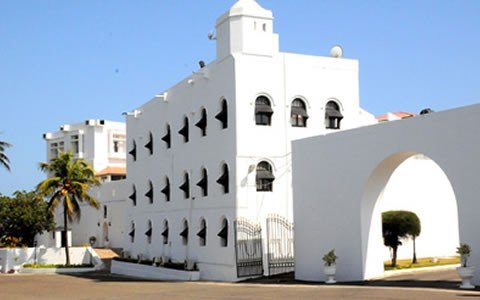The Osu Castle, also known as the Christiansborg Castle is located in Osu, Accra, Ghana on the coast of the Atlantic Ocean's Gulf of Guinea.
The Osu Castle has been the first substantial fort built by Denmark-Norway in the 1660s, though the castle has changed hands between Denmark-Norway, Portugal, the Akwamu, Britain, and finally post-Independence Ghana, and was rebuilt numerous times.
For most of the castle's history, it has been the seat of government in Ghana with some interruptions, the latest when the John Kufuor administration moved the seat of government to Golden Jubilee House after 6 January 2009, which was quickly reversed by the incoming John Atta Mills administration.
The area was first occupied in 1550 by the Portuguese, though in the 17th-century Portuguese influence diminished. The area came under the control of Sweden in the 1650s, led by the Dutch trader Henry Caerlof.
In 1652, he was given permission to build a small fortified lodge by the King of Accra, with whom he had previously done business.
In 1660, control passed to the Netherlands but it was soon lost to Denmark-Norway. In 1657, Caerlof had again traveled to Africa, this time representing Denmark-Norway. He aimed to conquer the forts he had previously established, which he found easy at Osu. In its early life, the Osu castle was primarily used in the gold and ivory trade, but under Dano-Norwegian control, it increasingly dealt with slaves.
Osu Castle was located close to two other forts. Fort Crèvecoeur was controlled by the Dutch and Fort James by the British. The settlement at Osu was too small to store sufficient goods to compete with the others. Consequently, Denmark-Norway purchased adjoining land and expanded the building, naming it Fort Christiansborg after the reigning King Christian V of Denmark-Norway. The main royal palace (or castle) in Copenhagen also bears the name Christiansborg. Denmark-Norway occupied the fort for most of the next 200 years, with some interruptions, and for much of that time, it served as the capital of the Gold Coast of Denmark-Norway.
In 1679 or 1680, the fort's Greek assistant commander incited a mutiny to murder the commander. Shortly after that, a Portuguese ship commanded by Julião de Campos Barreto visited the fort and agreed to purchase it. The fort was named Fort São Francisco Xavier after the Catholic missionary Francis Xavier. The Portuguese built a chapel and raised the bastions by three feet. The fort was abandoned on 29 August 1682 after the garrison mutinied and it became clear that Portuguese traders could not compete with the other Gold Coast powers. Danish forces returned in February 1683 after purchasing the fort back from the Portuguese. In 1685, Fort Christiansborg became the capital of the Gold Coast of Denmark-Norway, taking over from Fort Frederiksborg.
The Akwamu ethnic group occupied the fort in 1693 after overpowering the occupants (who were reduced by death and disease) while disguised as merchants. Asamani, the Akwamu leader, occupied the fort for a year, trading with merchants from many nations. In 1694, Assameni sold the fort back to Denmark-Norway for 50 marks of gold (400 troy ounces, worth £200,000 to £250,000 in 2008) but retained the keys, which are still in the ethnic group's possession to this day.
The early 18th century was not kind to the fort, and in 1722 the English reported it to be in disrepair. Extensions were made later that century, however, and structural improvements were made in 1824. The additional storerooms, garrison quarters, platforms, bastions, and houses resulted in the castle being four times the size of the original fort. In the 1770s, the Danes at Osu became involved in a conflict with Dutch-controlled Accra.
In 1850, the British bought all of Denmark's Gold Coast possessions for £10,000 (between £850,000 and £1.5m in 2007), including Fort Christiansborg. Denmark had been considering selling these outposts for some time. After the slave trade had been abolished they were expensive to run and brought little benefit. Britain experienced the same problems but was keen to prevent illegal slave trading and to prevent France or Belgium strengthening in the area.
1862, earthquake destroyed most of the upper floors, which were rebuilt in wood. Later that century, the castle became the seat of the colonial government. In 1950, the wooden upper floors were rebuilt according to the original Danish plans.
In 1957, when Ghana became independent, with Queen Elizabeth II as head of state, the fort became Government House, the residence of the Governor-General. When Ghana became a republic in 1960, it became the residence of Ghana's first president, Kwame Nkrumah.
In 2005, there was debate over whether Osu Castle should be replaced as the seat of government. President John Kufuor argued that his government should not sit at the castle due to its previous association with slavery and also because its facilities were inadequate. National Democratic Congress MPs, however, argued that the $50 m that a new presidential palace would cost would be better spent elsewhere.
Currently, the Osu Castle is no longer the seat of government but an extension to the Jubilee House with the offices of some Ministers located at the castle, also most Commission of Inquiries carry out their duties from the castle.
The present castle is made up of various extensions to the original and is thus in an unorthodox shape. It has many facilities for the use of employees, including a clinic, café, shopping centre, and a post office.
It also still accommodates a permanent garrison. The extensive gardens feature a wide variety of plants, both local and imported. They are used for the president's outdoor receptions and parties.
Read also:Â





